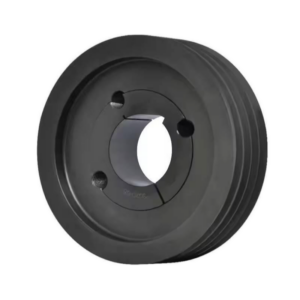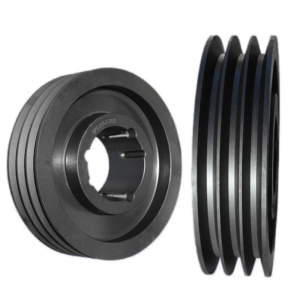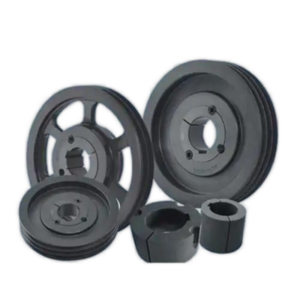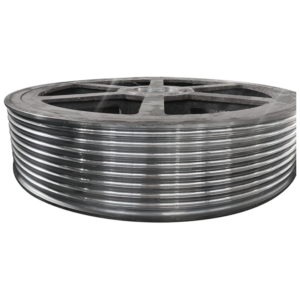Choosing the right V-belt for your equipment is more than just picking the first option you see—it’s a decision that impacts your machinery’s efficiency, longevity, and performance. Whether you’re replacing a worn-out belt or upgrading your system, understanding the key factors is essential. In this step-by-step guide, I’ll walk you through everything you need to know, from understanding how V-belts work and the various types available to selecting the right size and material for your needs. I’ll also cover how to properly tension your V-belt, match it with the right pulley system, and keep it running smoothly with regular maintenance. Let’s dive in and ensure that you make the best choice for your equipment, minimizing downtime and maximizing performance.
What is a V-Belt and How Does It Work in Power Transmission?
A V-belt is a type of flexible belt with a trapezoidal cross-section that’s commonly used in mechanical systems to transfer power between two or more rotating shafts. The design of the V-belt allows it to grip pulleys effectively, creating a stable and efficient power transmission without slippage. Unlike flat belts, which rely on friction for power transmission, V-belts use their shape and the pressure between the belt and pulley to maintain consistent motion. This makes V-belts ideal for a wide range of applications, from industrial machinery to automotive engines, where reliable power transfer is essential.
Key Factors to Consider When Choosing a V-Belt for Your Equipment
When selecting the right V-belt, several factors must be considered to ensure optimal performance. These include:
•Size: The width and length of the V-belt must match the specifications of your system. If the belt is too short or too long, it can result in inefficient power transfer or premature wear.
•Load Capacity: The V-belt needs to be rated for the load it will handle. Be sure to check the manufacturer’s recommendations to ensure the belt can withstand the power requirements of your equipment.
•Operating Conditions: The environment in which the V-belt operates matters—temperature, humidity, and exposure to chemicals can all impact the belt’s durability and performance.
Considering these factors will help you choose a V-belt that can effectively handle the demands of your equipment.
Understanding V-Belt Types: Classic, Cogged, and Synchronous
V-belts come in different types, each designed to perform under specific conditions:
•Classic V-Belts: These are the traditional, solid belts that are widely used in many applications. They’re ideal for moderate load-bearing tasks and are easy to maintain.
•Cogged V-Belts: Cogged belts have notched ribs on the underside, which allows them to bend more easily and handle higher speeds and tighter pulleys without losing efficiency. They’re great for high-speed or compact systems.
•Synchronous V-Belts: These belts are designed for high-precision applications, where synchronization between pulleys is critical. They have teeth that mesh with the pulley, ensuring precise timing in power transmission.
Each type has its own advantages depending on the specific needs of your machinery, so choosing the right one is essential for optimal performance.
How to Determine the Right V-Belt Size for Your Equipment
Correct sizing is crucial to ensure your V-belt works effectively. To determine the right size, you’ll need to measure both the length and the width of the belt. Typically, manufacturers provide sizing charts, but you can also measure the outside circumference of the belt and the distance between pulleys to ensure the correct fit.
Additionally, consider the belt’s pitch—the distance between the teeth or ribs of the belt if you’re using a cogged or synchronous version. Make sure that the V-belt you select matches the specifications required by your system to avoid underperformance or damage.
Material Options for V-Belts: Rubber, Polyester, and More
V-belts are made from a variety of materials, each offering different levels of durability and flexibility. Common materials include:
•Rubber: Rubber V-belts are the most common and cost-effective option, offering flexibility and resistance to wear. They are suitable for a wide range of applications.
•Polyester: Polyester V-belts are more durable and resistant to high temperatures. They’re ideal for industrial environments where belts may be exposed to heat or chemicals.
•Synthetic Rubber and Aramid: For applications requiring high strength and minimal elongation, synthetic rubber and aramid fiber belts provide exceptional performance.
Choosing the right material ensures that the V-belt will withstand the conditions it will be exposed to, offering longer service life and reduced downtime.
How V-Belt Tension Affects Performance and Efficiency
V-belt tension plays a key role in its performance and efficiency. If the belt is too tight, it can strain the motor and bearings, causing premature wear. If it’s too loose, it can lead to slippage, reducing power transfer efficiency and causing the belt to wear unevenly.
To find the correct tension, follow the manufacturer’s recommendations or use a tension gauge to measure the optimal tension for your system. Regularly checking and adjusting the tension will keep your V-belt running smoothly and reduce the likelihood of failure.
How to Match V-Belts with Pulley Systems for Optimal Operation
Proper matching of V-belts and pulleys is essential to ensure that the belt fits snugly and works efficiently. The pulley diameter and the V-belt’s size should be compatible to prevent slippage. When selecting pulleys, consider their groove angle and diameter to match the belt’s design.
Additionally, ensuring that the pulleys are aligned properly will prevent unnecessary wear and tear on both the V-belt and the pulleys. Misalignment can lead to uneven stress distribution, reducing the lifespan of both components.
The Role of V-Belt Maintenance in Preventing Failures and Downtime
V-belts are relatively low-maintenance, but regular checks are essential to ensure they continue to perform at their best. Some maintenance tips include:
•Inspection: Check for visible signs of wear, such as cracks, fraying, or glazing on the surface.
•Cleaning: Remove any debris or dirt that may have accumulated on the belt.
•Lubrication: V-belts usually don’t require lubrication, but certain high-performance belts may benefit from specific lubricants designed for the material.
Regular maintenance reduces the likelihood of unexpected failures, keeps your system running smoothly, and helps extend the life of your V-belts.
Common V-Belt Issues and How to Troubleshoot Them
V-belts can face several issues, such as:
•Slippage: If the belt slips, it’s often a sign of improper tension or a misaligned pulley. Adjusting the tension or realigning the system can resolve this issue.
•Wear and Tear: Over time, the belt may begin to show signs of wear. Replacing worn belts promptly helps avoid damage to other components.
•Noise: A squealing or squeaking belt could indicate that it’s too loose, too tight, or misaligned. Proper tensioning and alignment should fix this.
By troubleshooting these common issues early, you can avoid costly repairs and extend the lifespan of your V-belt and related machinery.
V-Belt Installation: A Step-by-Step Guide for Proper Setup
Installing a V-belt correctly is crucial for ensuring its long-term performance. Here’s a quick guide:
•Check Pulley Alignment: Before installing, make sure the pulleys are aligned properly to avoid unnecessary strain on the belt.
•Install the Belt: Place the V-belt over the pulleys, ensuring it fits securely in the grooves.
•Adjust Tension: Use the appropriate method to ensure the correct tension is applied.
•Test the System: Run the system at low speed initially to check for any issues with alignment or tension.
Proper installation ensures your V-belt works efficiently from the start and prevents operational problems down the road.
Conclusion
Choosing the right V-belt for your equipment isn’t just about picking a random part—it requires careful consideration of size, material, and compatibility with the system. By following these steps, you can select the ideal V-belt that ensures efficient performance, minimizes downtime, and prolongs the life of your machinery. Regular maintenance and timely replacements will also keep your systems running smoothly, allowing you to focus on your business without worrying about equipment failures.






